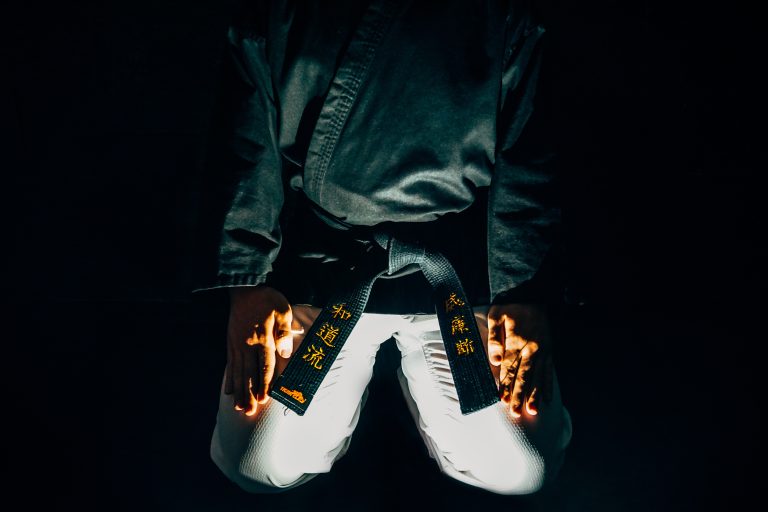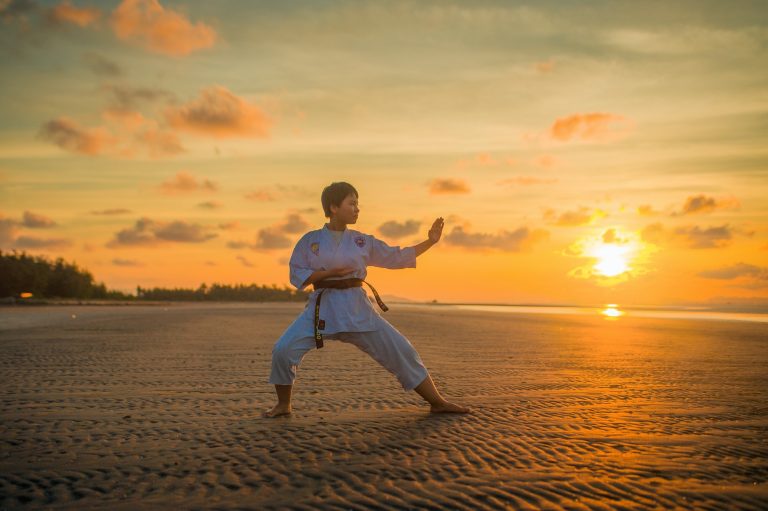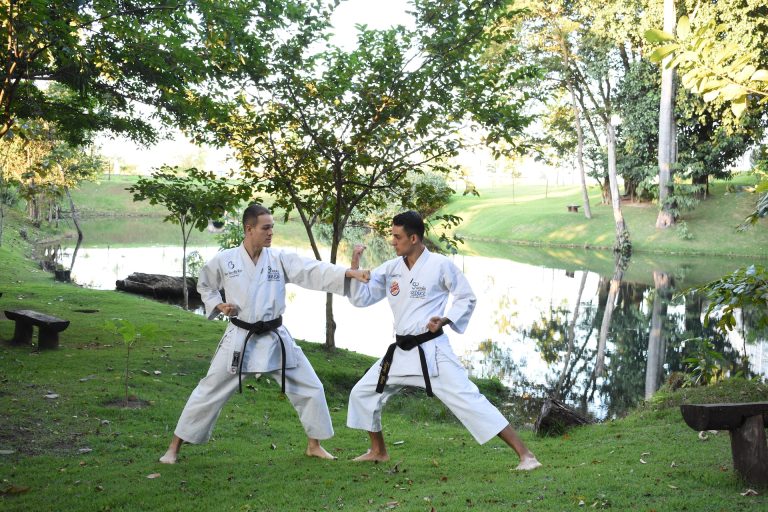What Does Karate Mean in Chinese?
Karate is a martial art that originated in the Ryukyu Kingdom (now Okinawa, Japan) in the 14th century. The word „karate“ is a Japanese term, but its roots can be traced back to China. In fact, the characters that make up the Japanese word „karate“ have their origins in the Chinese language.
The Origins of Karate in China
Karate can be traced back to the Shaolin Temple in China. Legend has it that a Buddhist monk named Bodhidharma (also known as Daruma in Japan) brought martial arts to the temple in the 6th century AD. The Shaolin monks developed a unique fighting style based on their physical and philosophical training. This fighting style later spread to Okinawa, where it evolved into karate.
The Chinese characters that make up the word „karate“ are 唐手, which in Japanese is pronounced „karate“. The first character, 唐 (tang), means „China“ or „Tang Dynasty“. The second character, 手 (te), means „hand“. Together, the characters mean „Chinese hand“ or „Tang hand“.
The Development of Karate in Okinawa
Karate was developed in Okinawa as a form of self-defense. Okinawa was a small island that was frequently invaded by larger countries, such as China and Japan. The Okinawans developed karate as a way to defend themselves against these invasions.
One of the most important figures in the development of karate in Okinawa was Gichin Funakoshi. Funakoshi was born in Okinawa in 1868 and began studying karate as a child. He later moved to Japan and introduced karate to the Japanese people. Funakoshi’s style of karate, Shotokan, is one of the most popular styles of karate in the world.
The Meaning of Karate Today
Today, karate is practiced all over the world. It is a popular martial art that is enjoyed by people of all ages. Karate is not just about physical training; it is also about mental discipline and spiritual growth.
The meaning of karate has evolved over time. Today, the word „karate“ is usually translated as „empty hand“. This refers to the fact that karate practitioners use no weapons in their training. Karate is a form of self-defense that relies on a combination of punches, kicks, and blocks.
What is Karate?
Karate is a Japanese martial art that originated in the Ryukyu Kingdom (present-day Okinawa, Japan) during the 19th century. It has evolved into various styles over time, but the fundamental principles of karate remain the same: using one’s body and mind effectively to defend oneself from an opponent’s attack.
What Does Karate Mean in Chinese?
Karate is not a Chinese martial art, so it does not have an inherent meaning in Chinese. However, karate is written in Chinese characters, and the characters used are pronounced as „kong shou“ in Mandarin Chinese. Kong shou translates to „empty hand,“ which refers to the fact that karate techniques involve using one’s hands, feet, and body to strike and block, in contrast to weapon-based martial arts.
What is the History of Karate?
Karate has a long and complex history that is intertwined with the history of Okinawa and Japan. The origins of karate can be traced back to the late 19th century, when Okinawan masters began teaching their martial arts to Japanese students. Over time, karate spread throughout Japan and eventually to other parts of the world.
During World War II, the practice of karate was banned in Japan, but after the war, it experienced a revival. In the decades that followed, various styles of karate emerged, each with its own unique techniques and philosophies. Today, karate is practiced worldwide and is recognized as an Olympic sport.
What Are the Benefits of Practicing Karate?
There are many benefits to practicing karate, both physical and mental. Physically, karate can improve strength, flexibility, endurance, and balance. It also teaches self-defense skills that can be valuable in real-life situations. Mentally, karate can help practitioners develop discipline, focus, and self-confidence. It can also provide a sense of community and camaraderie among practitioners.
What Are Some Common Techniques Used in Karate?
Karate techniques can be divided into two categories: strikes and blocks. Strikes involve using one’s hands, feet, or other body parts to deliver a blow to an opponent. Blocks involve using one’s body to stop an opponent’s attack. Some common karate techniques include punches, kicks, knee strikes, elbow strikes, and various blocks.
What Do Karate Belts Mean?
Karate belts are used to signify a practitioner’s level of skill and experience. The color of the belt indicates the practitioner’s rank, with white belts being the lowest and black belts being the highest. In between, there are various colored belts, such as yellow, orange, green, and blue. Different karate styles have different belt systems and requirements, but in general, practitioners must demonstrate proficiency in various techniques and show a level of mastery before being awarded a higher belt rank.
How to Understand the Meaning of Karate in Chinese
Karate is a popular Japanese martial art that has gained worldwide recognition. However, not many people know that the word karate has its roots in Chinese. The word “karate” is a combination of two Chinese characters: “kara” and “te”. “Kara” means “empty”, while “te” means “hand”. Therefore, karate means “empty hand” in Chinese.
If you want to understand the deeper meaning of karate in Chinese, you need to dive into the history and philosophy of this art. In this guide, we will take you through the steps to help you understand the meaning of karate in Chinese.
Step 1: Study the History and Origin of Karate
To understand the meaning of karate in Chinese, you need to know its history and origin. Karate originated in Okinawa, Japan, which was once a part of China. Karate was developed by the Okinawan people by combining elements of Chinese martial arts, such as Kung Fu, with their traditional combat techniques.
It was only in the early 20th century that karate was introduced to Japan and gained worldwide popularity.
Step 2: Learn About the Philosophy of Karate
Karate is not just a physical exercise; it’s a way of life that nurtures the mind, body, and soul. The philosophy of karate is based on the principles of respect, humility, and self-discipline. Karate teaches practitioners to be peaceful, yet strong, and to use their power only for self-defense.
One of the core concepts of karate is the idea of “muga-mushin”. Muga-mushin means “no mind, no thought”. It is a state of mind where you are completely focused on the task at hand, without any distractions or preconceived notions. This state of mind helps karate practitioners to react swiftly and with precision during a fight.
Step 3: Understand the Meaning of „Te“ in Chinese
Now that you know the history and philosophy of karate, it’s time to dive deeper into the meaning of “te” in Chinese. “Te” is a Chinese character that represents the hand or fist. In Chinese martial arts, “te” is used to describe striking techniques such as punches, chops, and kicks.
In karate, the techniques of “te” are combined with other combat techniques to create a unique form of martial art that emphasizes quick and powerful strikes. However, “te” also has a deeper meaning in karate philosophy. It represents the idea of using one’s body and mind in harmony to achieve a higher level of awareness and self-control.
Step 4: Explore the Meaning of „Kara“ in Chinese
The next step in understanding the meaning of karate in Chinese is to explore the meaning of “kara”. “Kara” is a Chinese character that represents the concept of emptiness or void. In karate, “kara” is used to describe the state of being empty, both mentally and physically, in order to be open and receptive to all possibilities.
For example, in karate, a practitioner must empty their mind of distractions and preconceptions to be fully present and focused on the present moment. This state of emptiness allows them to respond appropriately to any situation.
Step 5: Put It All Together
Now that you understand the history, philosophy, and meaning of the Chinese characters that make up the word “karate”, you can put it all together to understand the deeper meaning of karate in Chinese.
Karate is not just a physical exercise or a form of combat. It is a way of life that emphasizes the importance of mindfulness, self-discipline, and humility. The word “karate” represents the idea of using one’s empty hand to strike with precision and power, while also being open and receptive to all possibilities.
Conclusion
In conclusion, understanding the meaning of karate in Chinese requires a deep dive into its history, philosophy, and the meaning of the Chinese characters that make up the word. By understanding these concepts, you can gain a deeper appreciation for the art of karate and the way of life it represents.
Inhaltsverzeichnis






